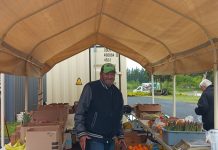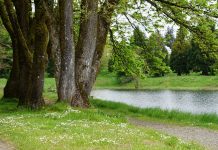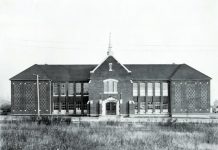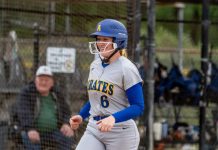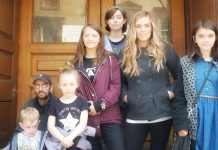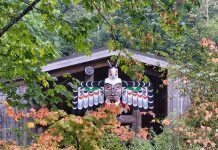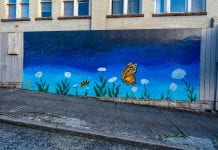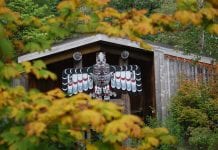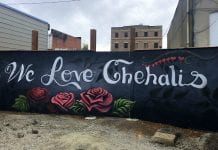By Nancy Keaton
 He immediately makes you feel drawn to him by his kind smile and warm handshake, a clasp with hands that have molded and shaped many intricately detailed pieces of bronze artwork. Jim Stafford, a Chehalis-native, is a world class artist who has brought bronze to life for charity, public art and private collections.
He immediately makes you feel drawn to him by his kind smile and warm handshake, a clasp with hands that have molded and shaped many intricately detailed pieces of bronze artwork. Jim Stafford, a Chehalis-native, is a world class artist who has brought bronze to life for charity, public art and private collections.
Stafford didn’t always want to work with bronze – he actually planned to be an illustrator. This desire was so great that after he took an art course by correspondence, Stafford received an invitation to meet with the incomparable Norman Rockwell at his home and studio in Massachusetts. There, Rockwell told Stafford, “You’ll do fine” and had him pose for an issue of Saturday Evening Post he was working on. This experience led him to be a speaker at the Rockwell Show in Sacramento and at the Tacoma Art Museum.
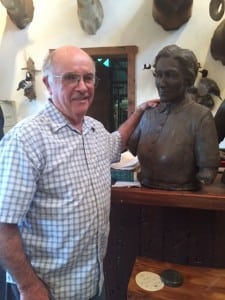
Stafford attended Burnley School of Professional Art in Seattle (now called the Art Institute of Seattle), then had the privilege of attending a wildlife painting internship in Jackson, Wyoming, still intending to be an illustrator. But fate had other plans. When Stafford ended up at Western Washington University in Bellingham, where they had an outdoor foundry, he started working with bronze in art classes. Students actually practiced with melting lead until they got good, then moved on to bronze. “We made a mess of the shop, though,” he laughs. “They sure didn’t like that.” But he liked working with bronze because it’s easy to work with and takes color well.
As Stafford walks through the steps to create a piece, it’s understandable that it is a messy process. A piece may begin as a drawing Stafford creates from scratch. Then on to molding and shaping clay or wax parts, dipping them in a slurry to build them up. Finally, 1,800 – 2,200 degree bronze is poured into the mold. Stafford says that the way he knows the bronze is ready to pour is by the color. “It’s like how a musician knows a song and knows when the slightest note is off or just right. I can watch the color and know exactly when it is just right,” he remarks.
Stafford has garnered many accolades over the years for his wildlife sculptures. He was named Cambridge’s Who’s Who Professional of the Year in bronze wildlife sculpture and voted into the Society of Animal Artists. He has been featured in Southwest Art Magazine and had a television documentary made about his work. Sports Afield magazine featured Stafford for his series on wild sheep, which are unique because of the coloring created by chemical patinas he has developed to shade the animals with realism.
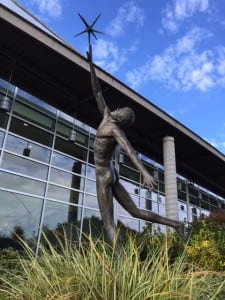
Stafford has perfected his craft over the past 40 years. He prefers working from live subjects because they are easier to copy. He made a striking likeness of his grandfather, Leonard Rayton, in the late 1960s, taking hours to meticulously measure his grandfather’s face, to get it perfect. Stafford is an avid hunter and has studied wildlife intensely. He has files with different kinds of antlers. When he creates the wildlife statues, he works the design up and around so the eye is drawn back into the piece again.
Working from pictures is challenging due to the lack of dimension but Stafford has done it, and very successfully so. He has created two works of art for Centralia College. The first one is called “Reach for the Stars” and shows a young man reaching into the sky. The most recent piece is of the two women – Katherine Kemp and Margaret Corbet – who kept the college going through the depression and a world war. It was a difficult project, working from an old faded picture. But the results are nothing short of amazing.
Stafford has shared his knowledge with others. He spent some time teaching art classes at Centralia College, and taught at Wenatchee Valley College for six years where he built two foundries. He has spent many years traveling to sportsman shows to sell his work and has an online presence with his website, Wildlife in Bronze.
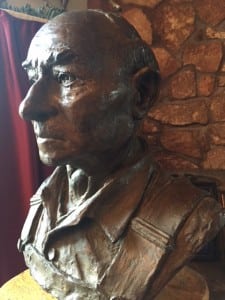
Stafford’s donations of bronze sculptures has helped many organizations raise funds, such as Foundation for North American Wild Sheep, Ducks Unlimited, Safari Club International, and even the Adna Schools Scholarship Program. Stafford’s best work for charity involved an elk statue that sold for $36,000 at the Rocky Mountain Elk Foundation auction.
“The Guardian” is a heartfelt piece that Stafford created for the Law Enforcement Memorial and can be seen in front of the entrance to the Lewis County Law and Justice Center. A memorial dedicated to the seven police officers and one K-9 who have lost their lives serving Lewis County, the piece shows not only the artistry Stafford possesses, but also a part of himself, the heart and soul and life that he breathes into every piece he creates.
To view more of Jim Stafford’s work, visit his website.





